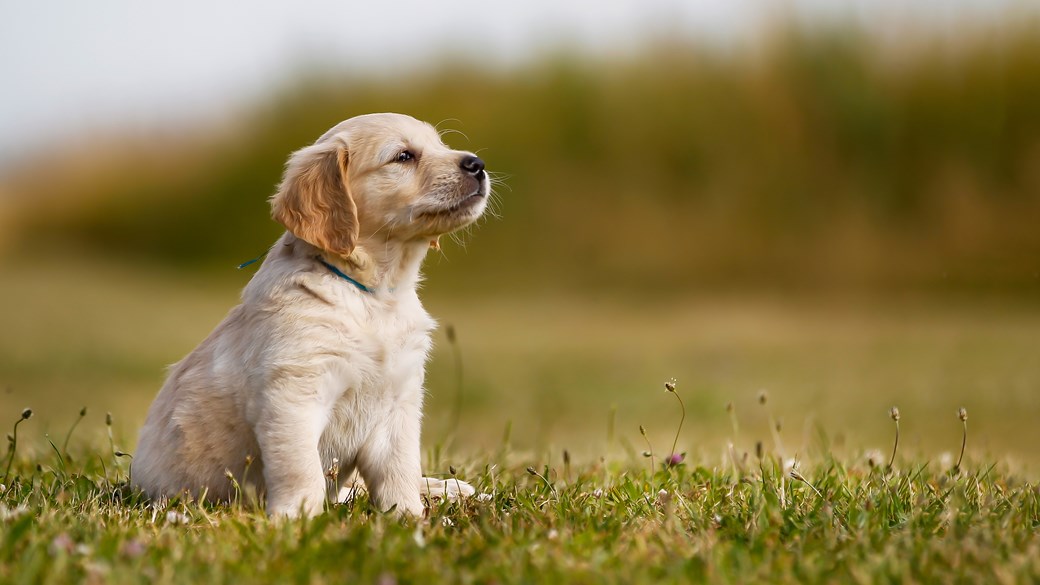
Teaching Your Puppy To Sit
A puppy that sits on command is a well behaved little dog!
Help your puppy learn that when you say “Sit”, you want them to sit down! With a little patience and lots of treats and praise, you should soon be able to train your pup to sit down when you ask.
Difficulty: Easy
Equipment: Treats and a calm environment
Time: 5-10 minutes at a time, a handful of times a day
Read more of our top dog training tips here.
More about training your puppy to sit
‘Sit’ is a really useful cue, especially as it helps with learning other good behaviours, like waiting at curbs, the ‘stay’ cue, or even being patient while you weigh out dinner! It’s usually one of the first cues we teach our dogs, and thankfully it’s not too difficult to teach.
Just like with all training, short, frequent sessions are better. The first thing to do is to get your environment right – distractions are the death of training, so make sure you have a quiet area, where your puppy can give you their full attention. It’s worth varying this location, so your dog learns the cue in a range of environments.
For successful training it’s also important to get your dog engaged with you. Usually, a fistful of yummy treats is enough to get that covered! Keep treat portions small, but big enough that your pup feels like they are worth the effort.
Start by getting their attention with your treats, then hold the treat just above your pups nose. If you’ve got the right treat and the right environment, hopefully your dog’s attention will be fixed on the treat in your hand. Slowly move your hand backwards towards their ears – don’t lift it up too high else they might jump up and you’ll have to restart.
As the treat moves backwards, most dogs will automatically sit down as they follow the treat – great! The second your dog’s bottom hits the floor, give positive reinforcement with a verbal congratulations such as ‘good dog!’ and by giving them the treat. Don’t let them get away with hovering; no food until they are properly sat down!
If they don’t sit, don’t worry! Just try again, with your hand or them in a slightly different position. Repetition is key to learning. Soon, your dog should sit down whenever you hold a treat near their nose. Make sure reinforcement is given whilst your dog is in position, otherwise they will break position to get the treat – a sure fire way to end up with a dog who pops their bottom down for half a second then jumps straight back up for their reward!
Now it’s time to add in the cue! Most people use ‘Sit’, but you can use whatever you like, so long as everyone in the family knows what the cue word or signal is. Say your dog’s name followed by the cue word as you hold the treat near them and they perform the movement. It’s important to only say “Sit” as they are sitting at first, so they associate the word with the correct action. Gradually, phase out the hand movement and just leave the cue word.
While ‘Sit’ is often branded as an easy command, some puppies don’t make anything easy! If you find yourself getting frustrated with your dog, always stop the training session.
Puppies are very sensitive and will quickly pick up on any negative messages. This includes telling them off – don’t forget your pup is still learning and doesn’t know what you want them to do. Being told off will be confusing and upsetting for them, and won’t help with getting them to enjoy training in the future!
Some tips include:
- If your dog reverses rather than sits down as you move the treat, try doing it with their back against a wall. That way there is nowhere for them to go, and they will be more likely to sit. It is also likely your hand is not quite in the correct position, for example too high, or you are moving the treat too far back. Play around with the movement and see what works.
- If your dog is jumping up, try holding the treat lower. It's also important not to pull the treat away if they move towards it, as this will encourage jumping and lunging. Just hold on tight, so they quickly learn they won't be getting the treat that way!
- If your dog is too excited to concentrate, try doing the training after exercise or after a meal when they might be a little more tired or relaxed.
- Sitting is an easy behaviour to capture, this means rewarding the behaviour when they perform it naturally. When your dog sits by themselves give the cue, and verbal praise and reward, as well as a click if you are using clicker training.
Join our VIP puppy club
Join our VIP club to receive advice, rewards, savings and a host of offers including £30 off Complete Care Junior or Complete Care. Plus, every swipe of your VIP card helps animals in need near you.

